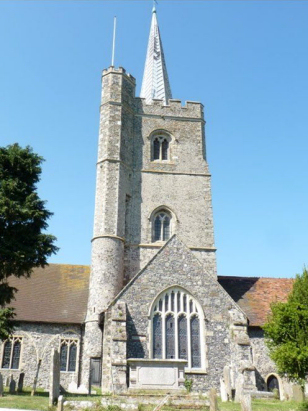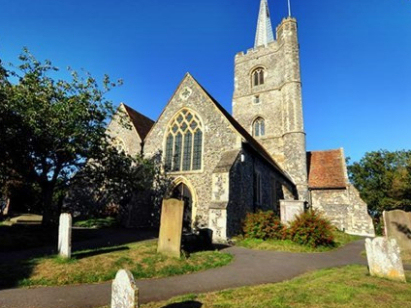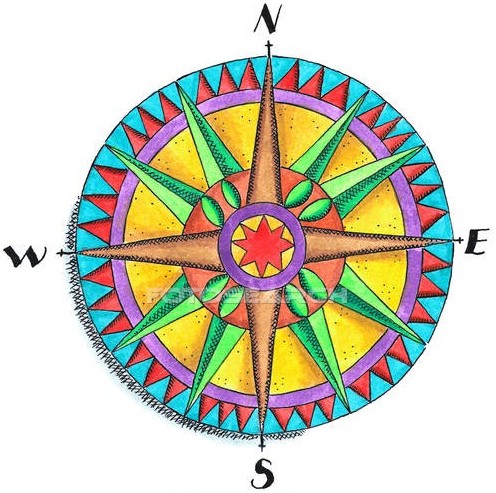
England
& Wales Hardwicke Marriage Index
Marriages
1754 - 1837
Ash by Sandwich St Nicholas
 |
England
& Wales Hardwicke Marriage Index |
The ParishThe parish of Ash (the qualifier is required to distinguish it from the other Ash in western Kent) lies in eastern Kent roughly 3 miles west of the port and market town of Sandwich. Ash sits on the former route of the A257 which connects Sandwich with Canterbury and which now bypasses the small town to its north, Ash is believed to have formed the first base for the Roman invasion of England which landed in Pegwell Bay to the northwest and is associated with their location of Rutupium. What is certain is that the route of the A257, being characteristically straight follows one of the first Roman Roads in Britain up to Canterbury. Today's Ash is a modest large village or small town with most properties lying between the old and new routes of the A257. The wider parish, however, one of the most extensive in eastern Kent was widely farmed with the majority using the traditional forms of arable and pastoral in roughly equal amounts, the balance being made from traditional Kentish crops with abundant orchards and hop grounds. Even today much of the ground between Ash and the River Stour is coloured on Ordnance Survey maps with the orchards iconic dotted green, modern glass-houses also occupy this fertile space, Modern developments have merely grazed the parish with the railway line from Canterbury to Sandwich just crossing into Ash parish for a short stretch of its run. Drainage for the parish eventually ends up in the Stour whatever its original direction, the area of Ash Levels being particularly man-influenced with a complex pattern of man-made ditches to carry water northwards. Ash is sited at 20 metres above the sea with the wider parish largely lower than that, a few spots along the A257 reach above 30 metres but it is to the south that a few more rise to 50 metres as local high points. As already mentioned Ash parish was very extensive, covering almost 6,900 acres and supporting a population of over 2,000 parishioners. Whilst Ash, itself, is not mentioned in Domesday Book the wider parish is covered under the entry for Fleet Manor, held by the Archbishop of Canterbury it clearly incorporates the settlement of Ash too as it was recorded in the top 20% of manors by population, it also held formidable assets of 75 ploughs together with woodland, a fishery and 2 mills making it a very wealthy holding indeed. |
 |
|
|

|
| Register No | Covering Dates | Deposited With | Register Style | Quality Standard | Comments |
| 1 | 11th August 1754 - 11th June 1783 | Canterbury Cathedral Archives - Reference -
CCA-U3-274/1/A/4 |
Standard preprinted and self-numbered combined Banns & Marriage register with 4 entries per page | Grade 2 Register - not a perfect read but with a low likelihood of misreads | None |
| 2 | 16th June 1783 - 1st December 1812 | Canterbury Cathedral Archives - Reference -
CCA-U3-274/1/D/1 |
Standard preprinted and self-numbered Marriage register with 3 entries per page | Grade 2 Register - not a perfect read but with a low likelihood of misreads | None |
| 3 | 18th January 1813 - 13th October 1836 | Canterbury Cathedral Archives - Reference - CCA-U3-274/1/D/2 | Standard Rose style preprinted and prenumbered Marriage register | Grade 2 Register - not a perfect read but with a low likelihood of misreads | None |
| 3 | 15th October 1836 - 9th May 1837 | Canterbury Cathedral Archives - Reference - CCA-U3-274/1/D/3 | Nonstandard Rose style preprinted Marriage register it is nonstandard in not being pre-stamped with its numbering that being left to the clerk to complete | Grade 2 Register - not a perfect read but with a low likelihood of misreads | None |
|
Stourmouth
All Saints
|
||
 |
||
|
Staple
St James
|
Woodnesborough
St Mary the Virgin
|
Woodnesborough
St Mary the Virgin
|
1760 1770 1780 1790 1800 1810 1820 1830
Corrections to Tinstaafl Transcripts